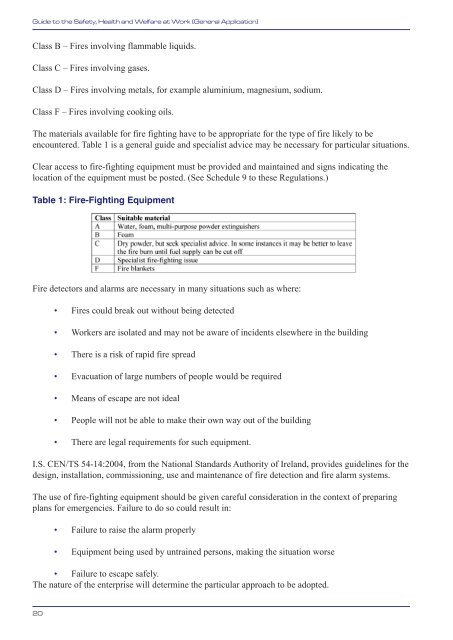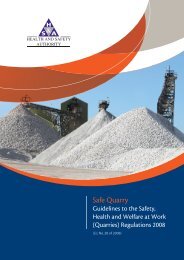Guide to the Safety, Health and Welfare at Work (General Application)
Guide to the Safety, Health and Welfare at Work (General Application)
Guide to the Safety, Health and Welfare at Work (General Application)
Create successful ePaper yourself
Turn your PDF publications into a flip-book with our unique Google optimized e-Paper software.
<strong>Guide</strong> <strong>to</strong> <strong>the</strong> <strong>Safety</strong>, <strong>Health</strong> <strong>and</strong> <strong>Welfare</strong> <strong>at</strong> <strong>Work</strong> (<strong>General</strong> Applic<strong>at</strong>ion)<br />
Class B – Fires involving flammable liquids.<br />
Class C – Fires involving gases.<br />
Class D – Fires involving metals, for example aluminium, magnesium, sodium.<br />
Class F – Fires involving cooking oils.<br />
The m<strong>at</strong>erials available for fire fighting have <strong>to</strong> be appropri<strong>at</strong>e for <strong>the</strong> type of fire likely <strong>to</strong> be<br />
encountered. Table 1 is a general guide <strong>and</strong> specialist advice may be necessary for particular situ<strong>at</strong>ions.<br />
Clear access <strong>to</strong> fire-fighting equipment must be provided <strong>and</strong> maintained <strong>and</strong> signs indic<strong>at</strong>ing <strong>the</strong><br />
loc<strong>at</strong>ion of <strong>the</strong> equipment must be posted. (See Schedule 9 <strong>to</strong> <strong>the</strong>se Regul<strong>at</strong>ions.)<br />
Table 1: Fire-Fighting Equipment<br />
Fire detec<strong>to</strong>rs <strong>and</strong> alarms are necessary in many situ<strong>at</strong>ions such as where:<br />
• Fires could break out without being detected<br />
• <strong>Work</strong>ers are isol<strong>at</strong>ed <strong>and</strong> may not be aware of incidents elsewhere in <strong>the</strong> building<br />
• There is a risk of rapid fire spread<br />
• Evacu<strong>at</strong>ion of large numbers of people would be required<br />
• Means of escape are not ideal<br />
• People will not be able <strong>to</strong> make <strong>the</strong>ir own way out of <strong>the</strong> building<br />
• There are legal requirements for such equipment.<br />
I.S. CEN/TS 54-14:2004, from <strong>the</strong> N<strong>at</strong>ional St<strong>and</strong>ards Authority of Irel<strong>and</strong>, provides guidelines for <strong>the</strong><br />
design, install<strong>at</strong>ion, commissioning, use <strong>and</strong> maintenance of fire detection <strong>and</strong> fire alarm systems.<br />
The use of fire-fighting equipment should be given careful consider<strong>at</strong>ion in <strong>the</strong> context of preparing<br />
plans for emergencies. Failure <strong>to</strong> do so could result in:<br />
• Failure <strong>to</strong> raise <strong>the</strong> alarm properly<br />
• Equipment being used by untrained persons, making <strong>the</strong> situ<strong>at</strong>ion worse<br />
• Failure <strong>to</strong> escape safely.<br />
The n<strong>at</strong>ure of <strong>the</strong> enterprise will determine <strong>the</strong> particular approach <strong>to</strong> be adopted.<br />
20

















